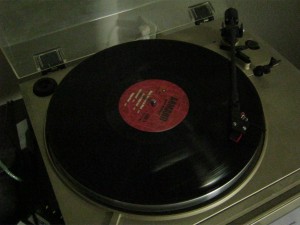Now, let’s get started with NFS, right? Well… first things first… this configuration is supposed to replace the BeagleBoard. As mentioned, I have occidentally overwritten its SD card. This also means I cannot access its current configuration.
I cannot login to the device anymore over ssh or serial connection due incorrect content of the root filesystem. However the NFS server is still serving perfectly fine. Since I cannot login, I cannot gracefully unmount the filesystems. The point is, I am listening to music. The music is on the USB hard disks connected to the BeagleBoard, which I will have to shut down in order to connect them to the Raspberry Pi to configure the mount points. If I could access the old configureation, I could just copy over the entries in /etc/fstab.
I will be using UUIDs to identify the partition to mount, as, when using USB, I cannot predict which device name it will have. I mean, if I disconnect, and reconnect the hard disks on a different USB port, I wish not to have to change the configuration. Therefore I will use UUIDs so no matter what device name it gets, it will work. So, let’s delay configuring the mount points to a later point. We will configure the mount points (same as currently on the BeagleBoard):
/mnt/1000 : 1000 GB USB HARD DISK, DATA
/mnt/1500 : 1500 GB USB HARD DISK, DATA
/home : 250 GB USB HARD DISK, HOME PARTITION
If I just create the directories, the rest of the procedure should work, and the actual hard disks can be added later. Let’s install the NFS software. Also… let’s install vim, the editor I am used to, as it isn’t installed by default in an ArchLinux installation (vi and nano are)
# pacman -S nfs-utils vim
For security reasons, we will set up an nfs root
# mkdir /srv/nfs4
# mkdir /srv/nfs4/1000
# mkdir /srv/nfs4/1500
# mkdir /srv/nfs4/andre
and add the following to /etc/fstab
/mnt/1000 /srv/nfs4/1000 none bind 0 0
/mnt/1500 /srv/nfs4/1500 none bind 0 0
/home/andre /srv/nfs4/andre none bind 0 0
and set up the exports in /etc/exports
/srv/nfs4/ 192.168.178.1/24(rw,fsid=0,no_subtree_check)
/srv/nfs4/1000 192.168.178.1/24(rw,no_subtree_check,nohide)
/srv/nfs4/1500 192.168.178.1/24(rw,no_subtree_check,nohide)
/srv/nfs4/andre 192.168.178.1/24(rw,no_subtree_check,nohide)
To start the nfs server, just now
# systemctl start nfsd.service rpc-idmapd.service rpc-mountd.service rpcbind.service
Verifying the exports from my desktop machine:
$ showmount -e 192.168.178.49
Export list for 192.168.178.49:
/srv/nfs4/andre 192.168.178.1/24
/srv/nfs4/1500 192.168.178.1/24
/srv/nfs4/1000 192.168.178.1/24
/srv/nfs4 192.168.178.1/24
Since this looks fine, I can enable startup during boot using
# systemctl enable nfsd.service rpc-idmapd.service rpc-mountd.service rpcbind.service
This is the new way of configuring services at boot, as compared to the old /etc/rc.conf method.
So, I guess it’s about time to shut down the BeagleBoard and replace it by the Raspberry Pi. Even though there are some more services to be configured, such as my IPv6 tunnel, printer server, scanner server, and so on. As I am unable to gracefully shut the BeagleBoard down, and due its instability, I guess I’d better fsck all the external hard disks before putting them online in the new configuration.
One thing to verify before proceeding is to verify the Raspberry Pi boots up headless, and I’ve heard this might be an issue. However, the system comes up perfectly fine.
In order to listen some music while these operations are in progress, I will revert to vinyl. The real way to listen to music ;)
PS. I bought this record last wednesday. It’s awesome to see new music appear on vinyl only ;)

